The 2011 National Railway Historical Society convention was planned for late June in Tacoma, Washington. Tacoma was just forty-five minutes south of where I lived in Lynnwood so there was no hesitation about attending. Chris Guenzler made his plans to visit several railway attractions in western Washington and Bob and I joined him in some of them. The adventures started on the Sunday prior to the convention with a visit to Yakima.
Yakima Valley Trolley History
The Yakima Valley Trolleys operate on the tracks of the former Yakima Valley Transportation Company in Yakima, Washington. The YVT is listed on the National Register of Historic Places because it is the last authentic, all-original, turn-of-the-century interurban electric railroad in the United States. The degree to which the complete YVT system has been preserved is unsurpassed.
The railroad was constructed between 1907 and 1913. Its greatest length was just over 44 miles. Presently approximately five miles of track remain, connecting the cities of Yakima and Selah. Electric trains have operated on the YVT trackage every year since 1907. Service was first limited to a streetcar line in downtown Yakima. In 1909 the YVT was purchased by the Union Pacific Railroad with the purpose of expanding the system as a feeder of freight and produce to the Union Pacific mainline. The YVT built a large stone and timber carbarn/shop facility in 1910. In 1911 a concrete and masonry powerhouse substation was constructed to provide the necessary DC electricity to operate the trolleys. Both buildings are still in use today. The overhead wire catenary is also original. Streetcar service became less and less popular as more Americans were able to purchase automobiles. Finally in February 1947, the YVT terminated streetcar service, however the electric freight trains continued to operate. In 1974 the City of Yakima purchased two streetcars from Portugal to revive passenger service as a tourist operation. The project also served as Yakima's Bicentennial project in 1976.
The Union Pacific Railroad decided to abandon the Yakima Valley Transportation Company freight operations in 1985. Almost all of the system was donated to the City of Yakima in the process, and has been open as a museum since that time. The Yakima Valley Trolleys organization was incorporated in 2001 to operate the railroad for the City of Yakima. Present and future generations are able to experience an early-American street railway almost exactly as it was 100 years ago and come to understand the important role transit held in developing the City of Yakima as well as the rest of the industrialized world. The above information from the Yakima Valley Trolley website.
The VisitA drive east on I-90 and south on I-82 found us in Yakima and we made our way to the Yakima Electric Railway Museum.
The power house, museum shop and ticket office.
Historical photos of Yakima Valley Trolleys.
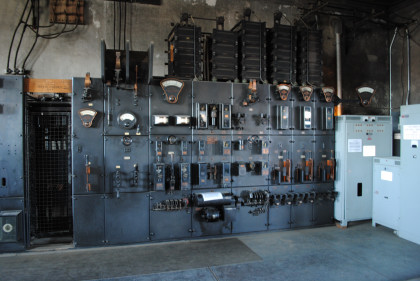
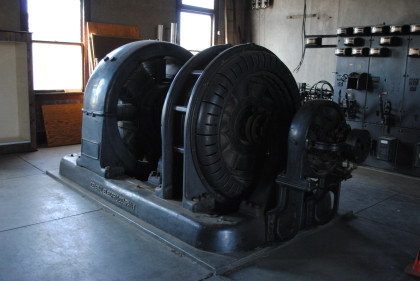
The power house equipment.
My ticket for my first ride on this unique railway.
Yakima Valley Trolley 1776 (nee 266 from Oporto Portugal) coming out of the car barn. Yakima acquired it in 1974 and it was the city's bi-centennial project.
The pole connected to the trolley wire.
The trolley at the boarding area.
The motorman inside the refurbished 1776.
Ready for the 10:00 trip. It was then that Bart and Sarah Jennings arrived. Bart was the NRHS convention chairman for the 2012 through 2015 events and has planned several rare mileage trips around the country over the years.
Switching the trolley pole to the other end of the streetcar.
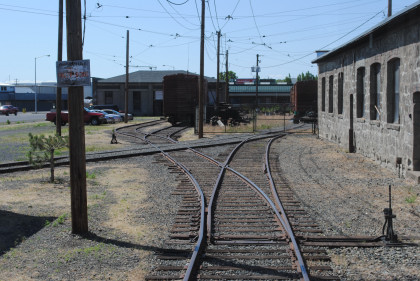
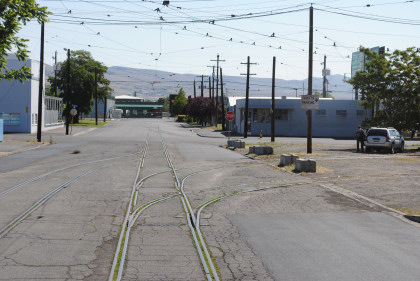
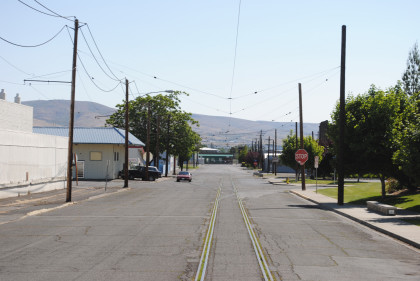
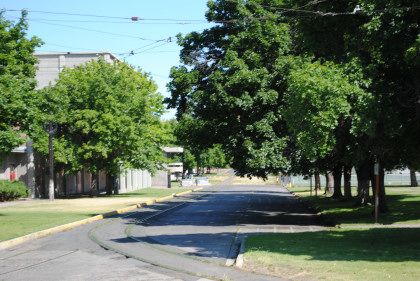
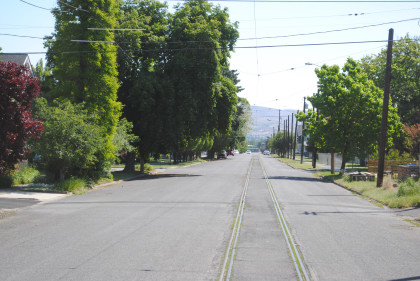
The trip out of the museum area and along West Pine Street.
We reached the end of the line at Treton Drive and Holton Avenue.
Looking forward to the end of the track. After a brief stop, we were underway again for the return trip.
A view down Pine Street.
Upon our return, we were given a tour of the car barn.
There is something about brick buildings that appeals to me.
Yakima Valley Transportation Brill streetcar 22, built 1930. It was one of three Brill Master Units built new for the YVT and operated in Yakima until 1947 when it was sold to the Portland Traction Company and ran there until 1958. 22 was then sold to Robert Hively and displayed at the Puget Sound Railway Historical Association museum in Snoqualmie, Washington and returned to Yakima in 1989. It is presently awaiting restoration to operating condition.
Flatbed Locomotive/Line Car A built by the Niles Car Company in 1910. It was built new for the YVT and used as a flatbed locomotive until 1922 when it was converted to a line car. It is presently in operating condition and has been in continuous service since 1910.
Steeple Cab freight locomotive 298 built by General Electric in 1922. It was built new for the YVT and operated in freight service from 1922 to 1985. It is presently in operating condition.
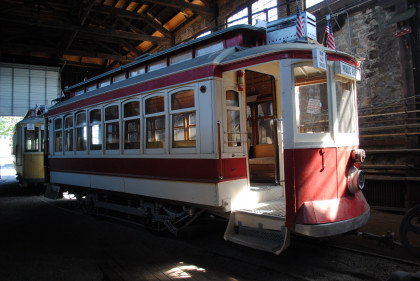
Yakima Valley Trolley 1976. It was built in 1928 and operated in Oporto, Portugal as streetcar 254. Similar in appearance to Yakima's first streetcars, it was also brought to Yakima in 1974 and was the second bi-centennial project. It has remained in continuous operation ever since.
After a very enjoyable ride, we drove to two other locations in Yakima for more railway-related items.
At Sarge Hubbard Park, the state's Merci boxcar is on display.
The plaque for the Merci car. Next is was to Track 29.
The sign for the outdoor shopping centre, Track 29, which was a series of businesses housed in boxcars connected by wooden walkways. It existed for a little over twenty-five years but most of the equipment was demolished in 2013 upon closure of the site.
Northern Pacific caboose 1020 which was acquired by the Northern Pacific Railway Museum in Toppenish in 2013 upon Track 29's demise.
There were eight boxcars in a row, each a different business. I have no idea if they were original to the railways for which they were painted, and since they no longer exist, that information will probably remain a mystery. However, this is the Great Northern boxcar, number unknown.
Next was Penn Central.
Third in line was Rock Island.
The fourth was Denver and Rio Grande.
That was followed by Southern Pacific Lines.
Santa Fe was the next boxcar.
The penultimate was Illinois Central.
Last, but not least, was The Milwaukee Road.
Union Pacific "Cascade Pass" (ex. UP maintenance-of-way 906032 1963, exx. UP "Pelham", nee UP 12 section/2 double-bedroom sleeper "Pelham" 1926), in which was Tequila's Mexican Restaurant.
Union Pacific 906021 "Douglas Fir" (ex. UP maintenance-of-way 906021 1963, exx. UP "Douglas Fir" 1948, nee Pullman 10 section/1 drawing room/
1 compartment sleeper 1928.)
Former U.S. Army hospital cars that were two of a group of 32 that went to the Alaska Railroad in 1947. Taylor Tots Child Care occupied these.
The Northern Pacific station in Yakima, home to the Depot Restaurant until that closed in November 2010.
Former Railway Express Agency building. A short drive down Yakima Avenue yielded these surprises.
Americana F7A 1502 (nee Alaska Railroad 1502) and moved to Yakima in 1985. Delaney's Electric Company operated out of these.
Atlanic Coast Line baggage-dorm 1518 "Fort Monmouth" (ex. Melco Labs {MELX} 1518 1980, exx. Amtrak 1518 1971, exxx. SCL 5018, nee ACL 105 1947).
Atlantic Coast Line "Fort Monmouth" and "Fort Benning" at Yakima.
Central of Georgia tavern/lounge/observation 692 "Fort Benning" (ex. MELX 692, exx. Patrick Hall) from the railway's Man O'War passenger train which ran from Atlanta to Columbus. This car was acquired in 2012 by the Southern Appalachia Railway Museum in Oak Ridge, Tennessee where it joined two other Central of Georgia Man O'War cars.
The Track 29 drumhead of "Fort Benning". With that, the drive home was next but plenty more new places, adventures and fun would ensue the next few days, all of which are subjects of separate travelogues.
| RETURN TO THE MAIN PAGE |